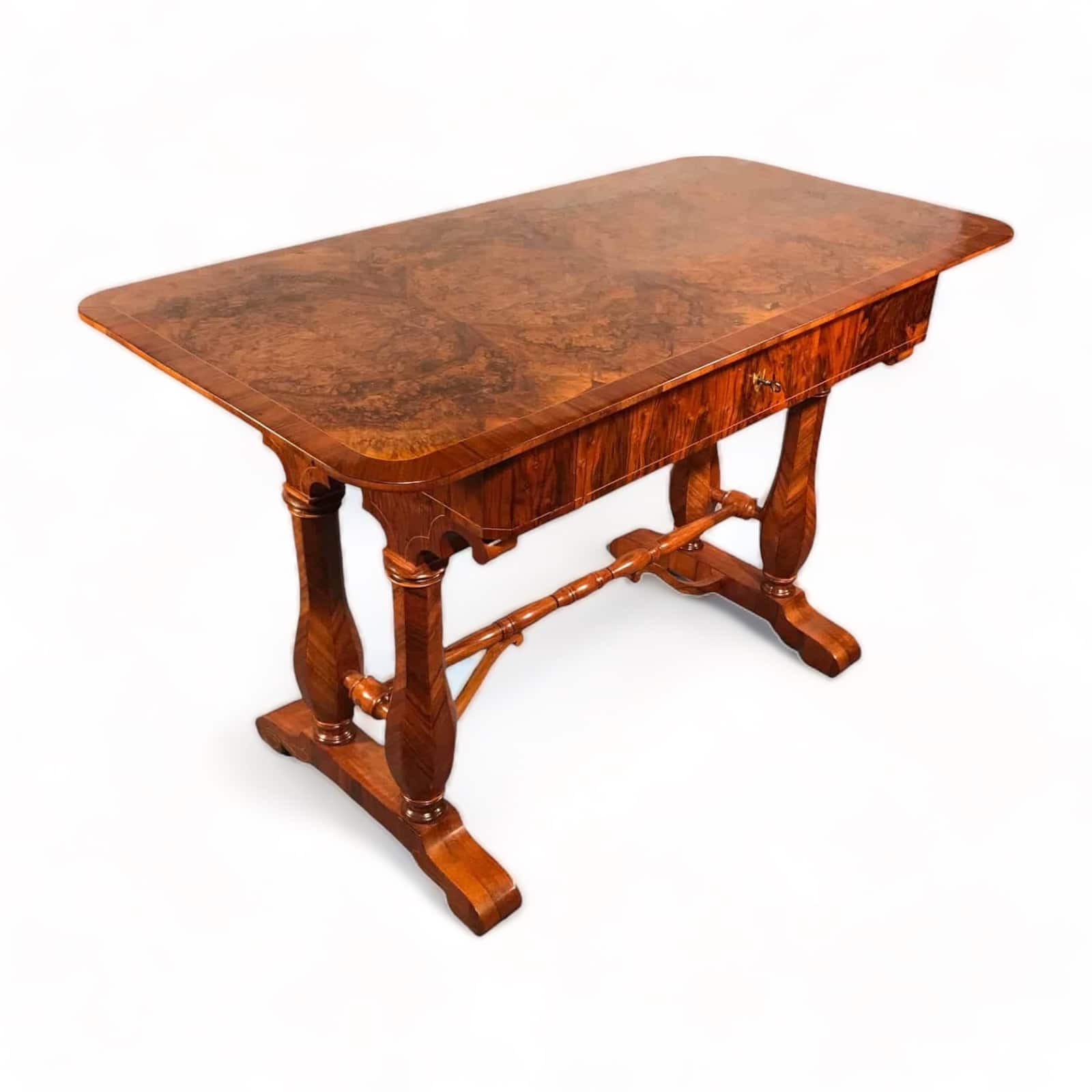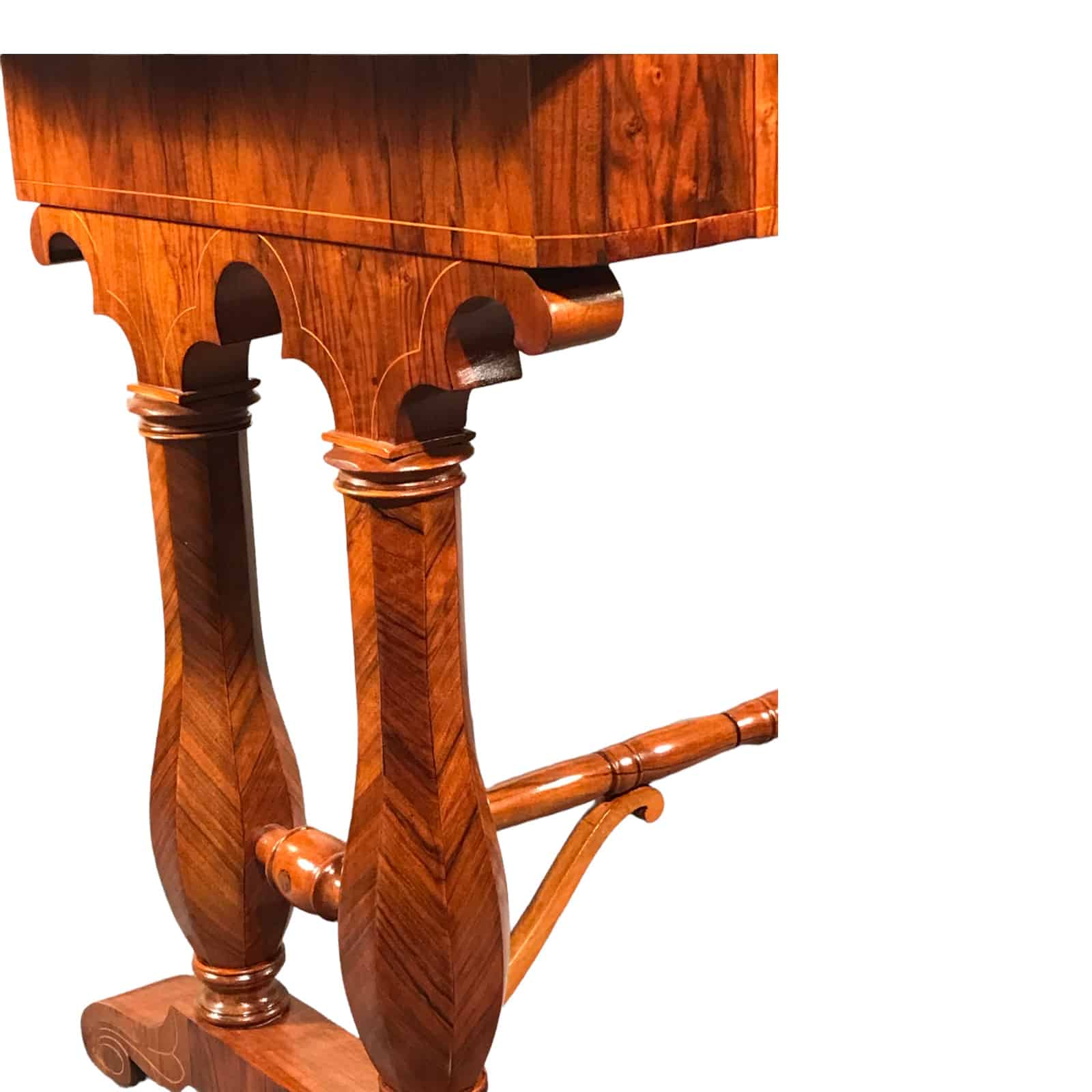Biedermeier Walnut Desk, Vienna 1820
29.53 x 49.61 x 27.17 inches (75 cm x 126 cm x D 69 cm)
Shipping From: Germany
Biedermeier Walnut Desk, Vienna 1820
This Biedermeier walnut desk comes from Vienna and dates back to 1820. It stands out for its exquisite walnut root veneer on the top of the table. Additionally, the hexagonal legs have an unusual herringbone veneer pattern. There is one central drawer in the apron of the table.
The design of this Biedermeier walnut desk shows the influence of the famous Austrian Biedermeier furniture designer Josef Danhauser (1780-1829). Danhauser was the leading furniture maker in Vienna at that time and had many royal patrons.
Historical Background
The early 19th-century Biedermeier style marks the transitional period between Neoclassicism and Romanticism.
The Biedermeier Period lasted from 1815 to 1848 after the end of the Napoleonic Wars.
It was a period of transition in Northern and Central Europe, especially in Germany and Austria.
After decades of war, Europeans wanted peace, and so reform movements and liberal ideas took a backseat.
As a result, authoritarian governments rose to power in multiple countries in the proceeding decades.
In Germany and Austria, a prospering middle class that was a permanent part of an industrialized, urban nation was still relatively new.
Despite their growing affluence, many middle-class citizens felt ambiguous about their standing and the future.
Domineering governments discouraged political activism, which led people to create comfort in their own lives.
Stylistically, Biedermeier furniture softened the rigidity of the Empire style. The cabinet makers used light, native woods and avoided the use of metal ornamentation.
Details
The desk comes in professionally refinished condition with a shellac hand polish. It measures 29.53 x 49.61 x 27.17 inches (75 cm x 126 cm x D 69 cm).
It ships from Germany and includes shipping costs to Boston.
Please also compare another Biedermeier desk on our site.
Please contact us via email, call us or chat with us on the site for any further questions.
| Product Dimensions: | |
|---|---|
| Height | 0 |
| Width | 0 |
| Depth | 0 |
| Date of Manufacture | |
| Restoration | |
| Condition | Unknown |
| Color | Brown |
| Country Of Origin | Austria |
| Item Condition | Good |
| Material | Walnut |
| Period | Early 19th century |
| Techniques | Veneer |
| Product style | Biedermeier |
| Shipping measurement: | |
| Height | 29.53 cm (11.63 in) |
| Width | 49.41 cm (19.45 in) |
| Depth | 27.17 cm (10.7 in) |
| Weight | 0 |
Be the first to review “Biedermeier Walnut Desk, Vienna 1820” Cancel reply
Schöne Aussicht 29
D- 69181 Leimen
Germany
Styylish has a huge network of shipping companies and can negotiate competitive quotes for worldwide shipping for you. Please ask us for a shipping quote before your purchase. We will make sure that you get a fair rate and do not pay too much!
Local Pick up
Local pickup allows customers to inspect an item at the time of pickup and avoid shipping costs.
White Glove Shipping
Item is delivered inside your home and placed in the room of your choice (installation and hookup are not included).
Local Deliveries
Local rates are available on most items where the delivery location is within 30 miles.
Shipping charges start at $150, depending on product type, size, location of the buyer. Local deliveries typically take up to 2 weeks.
Shipping within the Continental US
Flat rate shipping costs between $450-$750, depending on your location and the size of the item. The delivery usually takes between 3-5 weeks.
Express delivery can be organized but is subject to additional fees.
Overseas, Alaska and remote areas please ask for a shipping quote.
Parcel Delivery
Shipment is arranged through recognized carriers such as UPS, FedEx, and DHL.
Only pieces that can be safely packed in a box or envelope may be shipped via parcel.
Shipping charges start at $20 and vary based on the size, weight, packaging and the value of the item.
Items are typically delivered within 2 weeks of the purchase date.
The Styylish Buyer Guarantee ensures that you have complete peace of mind when making a purchase on Styylish in the event that your item:
- Does not arrive
- Is materially different than what you purchased
All sales are final on Made–to–Order items.
For all other items, sales are final 48 hours after delivery (Except Free Local Pickup and Local Delivery — see below).
To request a return, please email support@styylish.com and include the order number and the reason for your return request.
On approved returns, the buyer is responsible for full cost of return packing & shipping.
The items are insured during the shipping process and the shipper’s insurance will cover the cost for any damage caused by the shipper during the shipping process.
Local Pickup & Local Delivery
All sales are final once buyer or buyer’s agent takes possession of an item.
Upon inspection, if you decide not to move forward with the purchase, you or your agent must refuse the item at the time of pickup/delivery from the seller.
Once you have taken possession of the item, all sales are final.
Please contact support@styylish.com to let us know you did not accept the item and would like to initiate a refund.
Related products
Antique Furniture and Decor
Desks and Secretary Desks
Antique Furniture and Decor
Antique Furniture and Decor
Antique Furniture and Decor
Antique Furniture and Decor
Antique Furniture and Decor
Antique Furniture and Decor







Reviews
There are no reviews yet.